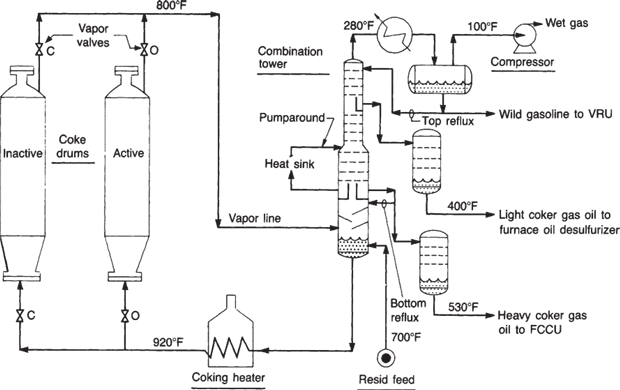By: Norm Lieberman, Process Engineering Consultant, New Orleans, LA

There are three key variables in maximizing refinery profitability for non-catalytic process units:
- Optimizing gas oil and atmospheric tower bottoms steam stripping, to recover virgin diesel.
- Minimizing vacuum tower flash zone pressure, to maximize the gas oil recovery.
- Minimizing delayed coker drum pressure, to minimize coke and gas yields.
Petroleum coke has a minimum value, as does the coker off-gas. Table 1 summarizes commercial plant test data obtained from a major U.S. refiner. It demonstrates the quite large benefit due to a substantial reduction in the operating pressure of delayed coker coke drums.
Note that the data in Table I was obtained at a constant heater outlet temperature, and not a constant coke drum outlet temperature. Also, the pressures shown are not coke drum pressures, but oil partial pressures (psia), which have factored in the effect of the heater coil velocity steam in the calculated reduction of the coke drum operating hydrocarbon partial pressure, as well as other steam flows into the coke drum themselves.
How to Reduce Coke Drum Pressures
The most direct way to reduce the coke drum hydrocarbon partial pressure is to use more coil steam in the heater passes. However, this will too often increase the condenser load in the fractionator overhead, increase fractionator pressure, and hence offset the effect on the reduced coke drum partial from the extra coil steam.
However, many years of commercial experience has shown the author that the most cost-effective way to reduce the coke drum operating pressure is to frequently hydro-blast the horizontal-run of piping in the overhead vapor line. Also, don’t forget the short section of vertical piping, just upstream of the vapor-line liquid quench.
Proper Quench Rate
Too much coke drum overhead vapor-line quench flow will promote excessive coke drum recycle. This will diminish coker liquid yields. To set the quench rate correctly, monitor the delta T between the top of the coke drum and the vapor line downstream of the quench injection point. This is best done by:
- Note the temperature downstream of the quench (typically 790°F).
- Shut off the quench flow, and wait 10-15 minutes.
- The vapor-line temperature should increase by 20°F (+ or – 5°F). Adjust the quench flow to achieve this 20°F target.
This is a more accurate method than relying upon dual TI points in the coke drum overhead vapor line, provided one remembers to turn the quench flow back on!
Overhead Vapor Valve Port Size
Only too often, the overhead vapor line isolation gate valves are not full-ported valves. Only too often, the author has found these valves to be 70% ports. Changing the valve port size from 70% to 90% on one unit reduced the coke drum vapor line pressure drop by approximately two psi. As the reader can calculate from Table I, that will be a substantial amount of incremental liquid yields, at the expense of coke and gas yields.
Of course, larger, and/or dual, coke drum vapor lines may be justified, as was done in one West Coast refinery. But, this is a multi-million dollar expenditure.
Reducing Fractionator Pressure
Some Delayed Cokers have a fractionator inlet pressure of 10 psig. But more commonly, many have a 30 psig inlet pressure. Again, the reader may calculate from Table I the huge liquid yield effects from reduced fractionator inlet pressure on delayed coker yields. One direct way to reduce the fractionator pressure is to enhance the tower’s air-cooled overhead condenser efficiency by the following steps:
- Install water mist nozzles below the air intake to cool the air flow by total water evaporation. The author has used this method, which he learned many times in Lithuanian refineries. The result has been (in areas of low relative humidity) a process outlet reduction in temperature of 3°F – 4°F. The fractionator overhead reflux drum pressure declined by approximately 2 psi. And the coke drum top pressure also declined by perhaps one psi. Not much, but the mist nozzles only cost $25 at the local Walmart.
Of greater consequence, is to:
- Check the belt tightness on the fan motor on air cooler fans.
- Set the blade pitch to 22.5° (max).
- Reverse the fan rotation for ten minutes to blow dirt off of the tube fins’ surface.
- Water wash the underside of the fins, taking care not to bend the delicate fins.
Not uncommonly, this may reduce the fractionator top pressure by 3 or 4 psi, and the coke drum pressure by perhaps two psi. Not a bad return for a half-day of work!
Slug washing the tube-side inlet once a month may also have a substantial benefit on reducing the fractionator top pressure. Wash the condensers one at a time, for maximum effect.
Fractionator DP
A Delayed Coker Fractionator with dual pumparounds may ordinarily have 25 – 30 trays, with an overall DP of 5 – 6 psi. One way to reduce this pressure drop by a large amount is to modify the tower’s internals, from valve trays to structured packing. Tower DP could then be reduced to one psi.
Use of structured packing in the Light & Heavy Coker Gas Oil Pumparounds is fine. The author has retrofitted many fractionators in this manner, with good results.
Use of structured packing in the fractionation zones is a recipe for disaster! Long experience by the author shows the problem is very poor liquid distribution of the internal reflux flows. Pumparounds, on the other hand, use a spray nozzle distribution assembly.
In summary, half of the fractionator DP can be eliminated by using beds of structured packing in the pumparound section, and grid type trays in the fractionation zones. (Use a valve lift of 17 mm for the fixed grid valve caps – never flutter type caps.)
Wash Oil Grid
The author, who has designed many coker fractionators in his 57-year career, only uses open spray-wash for the coke drum vapor wash oil or de-entrainment section. If vapor velocities are too high for just gravity settling, then a wash oil grid with a large crimp size of not more than two feet of depth should be used.
Approximately, a wash oil grid should be used if the flowing “C” factor exceeds 0.2 ft/second, where:
“C” = V • (DV ÷ DL)1/2
Where:
- V = Vertical velocity, ft/sec
- DV = Vapor density, lbs/ft3
- DL = Liquid density, lbs/ft3
The preceding recommendations assume that a well designed coke drum vapor feed distributor will be used. And, including for the larger diameter coker fractionators, a chimney tray distributor designed for a vapor pressure drop of one to two mm Hg.
Table 1
Plant test data of delayed coker yields vs. oil partial pressure, at 910°F heater outlet temperature.
| Coker Yields | ||
| Drum Oil Partial Pressure (PSIA) | 23 | 48 |
| 360°F – 650°F (wt. %) | 23.2 | 27.6 |
| 650°F + (wt. %) | 37.7 | 21.5 |
| Coke (wt. %) | 22.0 | 26.5 |
| Gas (wt. %) | 7.0 | 9.0 |
| Coker Naphtha (wt. %) | 11.1 | 15.4 |
| Vacuum Tower Upgrade The best way to reduce coke yield is to reduce delayed coker unit feed through improved vacuum tower performance. That is, by reducing the vacuum tower pressure with improved steam ejector performance. Many jets suffer from silicate deposits in the steam nozzle. These silicates are due to entrainment of boiler feed water in the jet’s motive steam. That is, wet steam. The silicates restrict the steam flow through the steam nozzle. To clear these hardness deposits:
|
About the Author

Norm Lieberman is a process engineering consultant. He graduated from Cooper Union (New York) in 1964 with a degree in Chemical Engineering. Lieberman worked for American Oil (1965 – 1981) as an operating supervisor and design engineer. He next worked for the Good Hope Refinery in Louisiana, advancing to plant manager in 1984.
Subsequently, he became a consultant to troubleshoot and design process equipment. Norm has written 11 books about troubleshooting refinery processes. He has taught 960 troubleshooting seminars attended by 21,000 operators and engineers in the past 35 years. Norm’s books can be found at pennwellbooks.com.
Connect with Norm on LinkedIn.








Hi Norman,
This type of troubleshooting is really interesting and, having been involved in refining processes in the past, it is very useful for eliminating operating constraints.
However, to combat the increase in condenser load in the fractionator head systems, it is also possible to provide supercooling with chillers on the condenser water circuit by cooling the water arriving from the cooling towers down to 5 degrees min.
The system is certainly energy-intensive but highly efficient, bringing other benefits too, such as flexibility in plant management, a reduced temperature of the feed entering the fractionation column and potentially reduced fuel gas consumption and therefore lower CO2 emissions.
These systems are in place in several refineries in Europe, mainly on CDUs and VDUs, but also on the primary fractionation of FCCUs and hydrocrackers units.
What is your opinion?
I would like to take this opportunity to thank you for your publications and work, which are appreciated by a very large number of refinery process engineers.
Best regards,
Gilles Revial
I have had experience using misters on the underside of heat exchangers. I would caution there use if the water supply contains a high mineral content. The sprays worked great for the first year but the fins/tubes became coated with a mineral build-up and became less efficient. Just an FYI